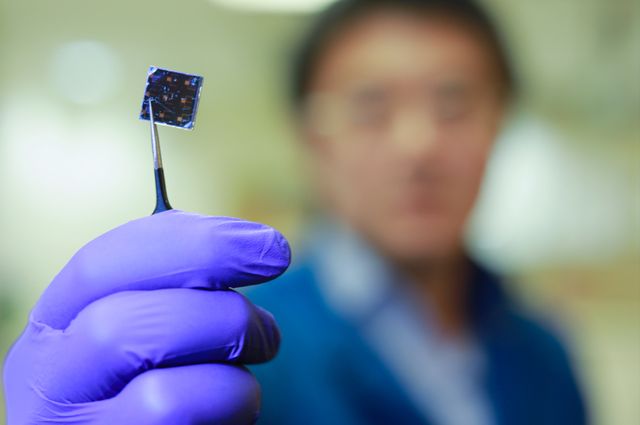The University of California, Los Angeles (UCLA)’s Samueli School of Engineering has developed a tandem solar cell, by spraying a perovskite layer onto a commercially available solar copper-indium-gallium-selenide (CIGS) cell.
The cell developed by UCLA set a new efficiency record for this type of tandem cell, at 22.4%, surpassing the 17.8% efficiency achieved in 2016 by a collaboration of European research institutes, which developed a peroskite/CIGS mini-module measuring 3.76cm².
The device, described in the paper High-performance perovskite/Cu(In,Ga)Se2 monolithic tandem solar cells, published in the journal Science, consists of a 2mm glass substrate, a 2 micron thick CIGS layer, and a 1 micron thick perovskite layer sprayed on top of it. The researchers report that the device maintained 88% of its initial efficiency after 500 hours under continuous 1-sun illumination, without an encapsulant.
The CIGS cell used in the research has 18.7% efficiency by itself, which is boosted by the perovskite’s ability to absorb a different part of the light spectrum. UCLA Professor of Materials Science, Yang Yang stated that devices using similar designs could reach efficiencies above 30%, and that would be the group’s next goal.
Key to the performance here is the interface between the two layers, which the researchers designed to increase the voltage, and therefore the output of the device. “We used nanoscale interface engineering of the CIGS surface and a heavily doped poly[bis(4-phenyl)(2,4,6-trimethylphenyl)amine] (PTAA) hole transport layer between the subcells that preserves open-circuit voltage and enhances both the fill factor and short-circuit current,” read the paper’s abstract.
While the device developed by UCLA is far smaller than any commercial solar device, Yang stated that the processes used could easily be scaled up and incorporated into existing PV manufacturing set ups.
Much recent research has focused on the development of perovskite/silicon tandem cells, with Belgium’s imec recently surpassing 27.1%. While so far, less efficient, CIGS/perovskite tandems have the potential to be much lighter than tandem cells, and the rapid build out of CIGS production capacity currently underway in China could provide opportunities for future commercialization.
This content is protected by copyright and may not be reused. If you want to cooperate with us and would like to reuse some of our content, please contact: editors@pv-magazine.com.









1 comment
By submitting this form you agree to pv magazine using your data for the purposes of publishing your comment.
Your personal data will only be disclosed or otherwise transmitted to third parties for the purposes of spam filtering or if this is necessary for technical maintenance of the website. Any other transfer to third parties will not take place unless this is justified on the basis of applicable data protection regulations or if pv magazine is legally obliged to do so.
You may revoke this consent at any time with effect for the future, in which case your personal data will be deleted immediately. Otherwise, your data will be deleted if pv magazine has processed your request or the purpose of data storage is fulfilled.
Further information on data privacy can be found in our Data Protection Policy.